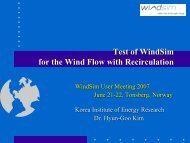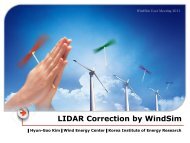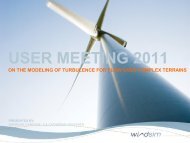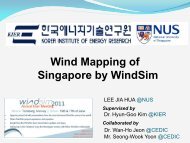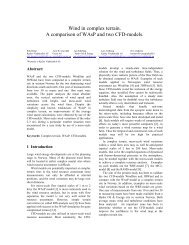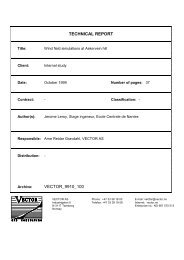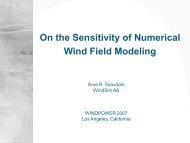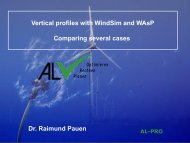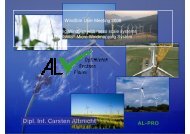wind energy resource evaluation in a site of central italy ... - WindSim
wind energy resource evaluation in a site of central italy ... - WindSim
wind energy resource evaluation in a site of central italy ... - WindSim
You also want an ePaper? Increase the reach of your titles
YUMPU automatically turns print PDFs into web optimized ePapers that Google loves.
ConclusionsIn this thesis the <strong>evaluation</strong> <strong>of</strong> <strong>w<strong>in</strong>d</strong> <strong>energy</strong> <strong>resource</strong>s over a <strong>site</strong> <strong>in</strong> <strong>central</strong> Italy wasconducted by means <strong>of</strong> the CFD code W<strong>in</strong>dSim.A series <strong>of</strong> 2D simulations were performed <strong>in</strong> order to validate the code. The codevalidation process brought to f<strong>in</strong>d the correct discretization parameter capable toguarantee grid-<strong>in</strong>dependent results. The “wall with no friction” boundary condition,to be applied at the top <strong>of</strong> the geometrical model was chosen, <strong>in</strong> order to describe aneutral stratified ABL. The comparison <strong>of</strong> the CFD results with numerical andexperimental results found <strong>in</strong> literature showed a fair agreement.The second part <strong>of</strong> the study concerned the <strong>evaluation</strong> <strong>of</strong> the <strong>w<strong>in</strong>d</strong> <strong>resource</strong>s o a <strong>site</strong><strong>in</strong> Central Italy. The experimental <strong>w<strong>in</strong>d</strong> data <strong>of</strong> two measurement masts (withmultiple measurement stations) were reduced and statistically analyzed.Tak<strong>in</strong>g advantage <strong>of</strong> the validation phase results, 3D simulations were carried out fora geometrical model reproduc<strong>in</strong>g the complex orography <strong>of</strong> the <strong>site</strong>. Firstly, acorrect value <strong>of</strong> the free stream velocity <strong>of</strong> the geostrophic <strong>w<strong>in</strong>d</strong> was found, to avoidconvergence problems. A “nest<strong>in</strong>g technique” <strong>in</strong> a coarse grid model was used toreduce the computational <strong>resource</strong>s.F<strong>in</strong>ally the simulations over a 14x14 km extended model with f<strong>in</strong>e grid resolutionhave been performed and the <strong>w<strong>in</strong>d</strong> field over the whole <strong>site</strong> was calculated.The results <strong>of</strong> the CFD calculations have been processed, <strong>in</strong> order to establish acomparison between experimental data and calculated values. The Vertical pr<strong>of</strong>iles<strong>of</strong> velocity and <strong>of</strong> turbulence <strong>in</strong>tensity allowed the <strong>evaluation</strong> <strong>of</strong> RMS errors aga<strong>in</strong>stthe experimental data. RMS errors <strong>of</strong> velocity pr<strong>of</strong>iles exhibit a direct relation withthe mean velocity <strong>of</strong> the directional sector, hereby show<strong>in</strong>g a strong dependence onthermal effects. Indeed, these effects are not taken <strong>in</strong>to account by the CFDsimulations, whose numerical model is addressed to reproduce a neutral ABL. Theanalysis <strong>of</strong> results on the <strong>w<strong>in</strong>d</strong> rose sectors allowed to f<strong>in</strong>d a range <strong>of</strong> mean velocity(3÷4 m/s) that discrim<strong>in</strong>ate whether or not data are <strong>in</strong>fluenced by thermal effects.For high mean velocity a fair agreement was evident.126




